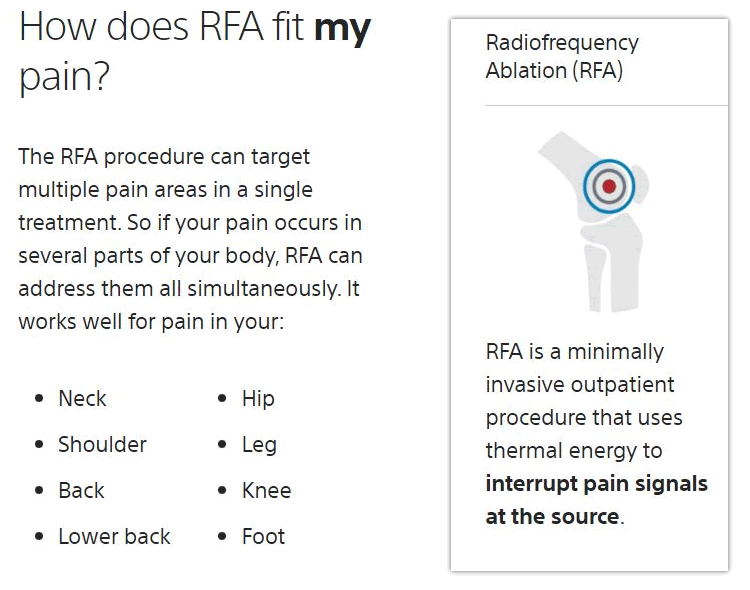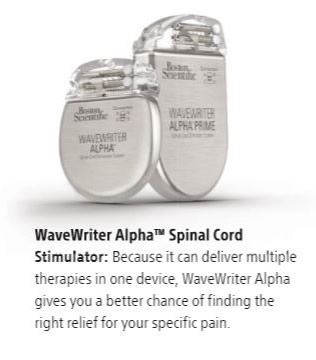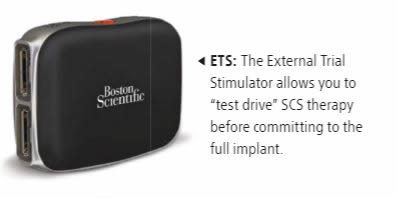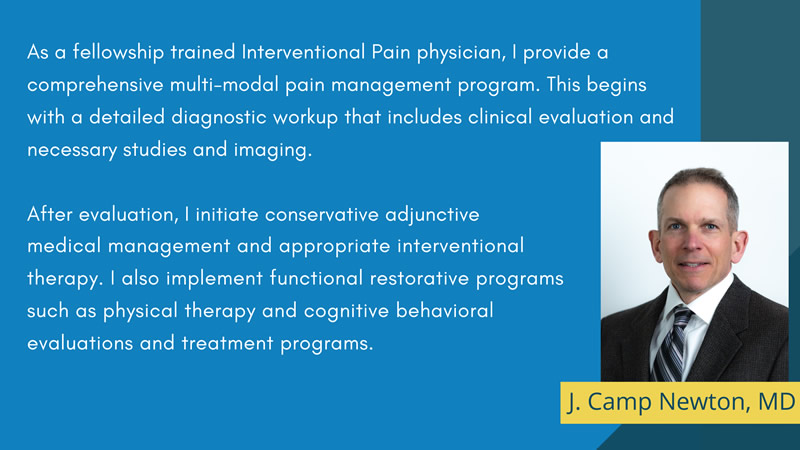
FAQ: Radio Frequency Ablation Therapy and Spinal Cord Stimulators
Our goal at Columbia Orthopaedic Group is to get people living with chronic pain back to their normal lives, with less pain and more mobility.
Radio Frequency Ablation Therapy
Q. Am I the right candidate for Radio Frequency Ablation Therapy (RFA)?
 A: Radiofrequency spinal ablation is a nonsurgical treatment that is particularly effective at relieving certain types of back pain and neck pain. Radiofrequency spinal ablation, also called rhizotomy, is a minimally invasive procedure that uses heat to ablate the nerve that is transmitting pain signals to the brain. It is most effective for facet joint pain and facet mediated pain, both of which cause lower back pain.
A: Radiofrequency spinal ablation is a nonsurgical treatment that is particularly effective at relieving certain types of back pain and neck pain. Radiofrequency spinal ablation, also called rhizotomy, is a minimally invasive procedure that uses heat to ablate the nerve that is transmitting pain signals to the brain. It is most effective for facet joint pain and facet mediated pain, both of which cause lower back pain.
Dr. Camp Newton, COG pain management specialist will start with an exam to inject a local anesthetic at the location of the nerves. This process simulates radiofrequency ablation. If the patient feels no pain, then RFA treatment is an excellent option.
Q. How is spinal ablation (RFA) performed?
A: Radiofrequency spinal ablation is an in-office procedure performed at Dr. Newton's office at The Columbia Orthopaedic Group in Columbia, MO.
Before the procedure, you will have your choice to have a mild sedation. During the procedure, Dr. Newton inserts a thin metal probe into the affected area. The probe emits radiofrequency energy that creates heat and debilates & disrupts the nerve tissue that is causing pain. Once the RFA lesion is created, the pain-transmitting ability of the nerve fibers is lost and pain signals from the source (facet joint) do not reach the brain.
Spinal ablation takes about 15-20 minutes. Most patients begin work and mild activity in a few days, and recover fully within two weeks.
Q. How long does pain relief last with a spinal ablation?
Radiofrequency spinal ablation typically provides about 6-12 months of relief. In all patients, the nerves will grow back. In some, however, the nerves may grow back without reinstituting the pain. In patients whose pain returns, ablation can be repeated. The majority of insurance plans cover radiofrequency ablation.
Spinal Cord Stimulators
Q. Am I a candidate for Spinal Cord Stimulator Therapy (SCS)?
 A: A spinal cord stimulator is an implanted device that is controlled outside the body by the patient. A remote with an antenna controls the level of stimulation that interrupts pain signals. This means that when it is successful, the patient can resume the majority of their regular activities without worrying about chronic pain.
A: A spinal cord stimulator is an implanted device that is controlled outside the body by the patient. A remote with an antenna controls the level of stimulation that interrupts pain signals. This means that when it is successful, the patient can resume the majority of their regular activities without worrying about chronic pain.
The field of spinal cord stimulation has increased rapidly in recent years due to advancements in technology and has been used for almost 30 years to help patients reduce chronic pain and opioid usage.
To determine which individuals will benefit from the treatment, Dr. Newton will start with an exam to determine pain history, physical condition, medication regime, meeting requirements for surgery and managing expectations. Most patients selected for spinal cord stimulation (SCS) usually have had chronic pain for more than 6 months in the lower back, leg, or arm. In patients with multiple areas of pain, SCS can be customized to provide pain relief for all pain points. A general condition known as failed back surgery syndrome is one of the most common reasons spinal cord stimulation is used.
Q. If I'm allergic to metals like nickel, can I have a Spinal Cord Stimulator?
A: No, having a metal allergy or sensitivity will not affect implantation for patients who are considered to be a candidate for a Spinal Cord Stimulator (SCS).
Q. Can I still get an MRI if I have a Spinal Cord Stimulator?
A: Both the Intellis™ and Vanta™ SCS devices integrate SureScan™ MRI technology, providing MRI access anywhere in the body with normal operating mode power settings.
Q. How long can I keep the Spinal Cord Stimulator implanted?
A:
The lifespan of a spinal cord stimulator is more about the battery than the device itself. Those devices with non-rechargeable batteries generally need to be surgically replaced every two to five years. If you have a rechargeable device, the lifespan is ten years or more.
Q. What happens if the Spinal Cord Stimulator doesn't work?
A: Spinal cord stimulation is recommended when other treatments have not been successful, when surgery is not likely to help, or when surgery has failed. Patients undergo a trial period first to determine if the minimally invasive treatment is an effective option to improve the patient's functionality and decrease the need for pain medication.
The trial procedure usually takes about 20 to 30 minutes. Leads, which are thin, flexible wires, are placed near the spine using a special needle. The leads are connected to an external wireless neurostimulator that is secured to the patient's back during the trial. The trail will last 5-7 days with a return visit with Dr. Newton to assess pain levels, sleep and daily activities.

Q. If I have Fibromyalgia, am I a candidate for Spinal Cord Stimulation or Radio Frequency Ablation Therapy?
A: Fibromyalgia is a condition that causes pain all over the body (also referred to as widespread pain), sleep problems, fatigue, and often emotional and mental distress. Because the pain is musculoskeletal, Spinal Cord Stimulators and Radio Frequency Ablation Therapy are not effective.
Q. If I've had back surgery, am I a candidate for Spinal Cord Stimulation?
A:
A general condition known as failed back surgery syndrome is one of the most common reasons spinal cord stimulation is used. The term describes chronic pain after one or more back or neck surgeries fails to alleviate persistent low back pain, leg pain (sciatica or lumbar radiculopathy) or arm pain (cervical radiculopathy).
Q. What can I expect for a Spinal Cord Stimulator implant Procedure?
A:
Spinal cord stimulator implantation is a process that usually involves two procedures. The first is a "trial" procedure. The second (if the trial succeeds) will involve the full surgery to implant the pulse generator or battery.
The location of the leads on your spinal cord can vary. For most people, the best place is in your back at about the same level as the lower edge of your breastbone (sternum). For those with pain in the arm, the neck may be a possible option for placement.
During this procedure, which involves general anesthesia, Dr. Newton will perform surgery to place permanent leads in the same location as the trial. A needle is inserted into a 2-inch incision area around the spinal canal called the epidural space, guided by fluoroscopy (a type of X-ray). The needle contains thin, insulated wires, called leads, with electrical contacts attached. The incision is closed and the person begins recovery.
Q. Will your spinal cord stimulator set off security at airports when traveling?
A:
Yes, airport security gates will detect your stimulator, Dr. Newton will give you an identification card that may allow you to bypass the machine.
Q. Can I swim with a spinal cord stimulator?
A:
Swimming is fine with a permanent, implanted generator, but you cannot get your temporary stimulator wet. You will need to avoid baths and showers during that short trial period.
Q. Can a spinal cord stimulator be removed?
A:
Yes, a spinal cord stimulator can be removed safely if you are unsatisfied with the level of pain relief it provides or if there is an infection or mechanical problem with your system.
Q. Can I still do strenuous work/job if I have a Spinal Cord Stimulator implanted?
A:
After both the trial and permanent surgery, it is recommended to limit physical activity. This includes exercise or any work that involves twisting, stretching, or reaching overhead. These actions can cause your stimulator to move away from the treatment area. You can resume slow, gentle walks a few days after surgery, but take at least two days off to rest and recover.
For at least the first two weeks, do not lift anything heavier than five pounds. Once your incisions are healed, you may begin to gradually increase physical activity, including any previously enjoyed activities and work activity. Please see your doctor as recovery varies from person to person.
Q. When will I experience pain relief?
A:
A spinal cord stimulator implant is considered successful when you experience at least a 50% reduction in pain. You should know within the week of your trial implant if a spinal cord stimulator is right for you.
At Columbia Orthopaedic Group, our highly experienced pain management team has performed hundreds of spinal cord stimulator trials and procedures over the last 12 years with great success.

We work hard to diagnose the cause of your pain fast, so we can develop a treatment plan that works for you. To find out more about treatment options and specialized care, please call Columbia Orthopaedic Group at (573) 876-8141 and schedule an appointment or request one below:
We look forward to meeting you!
Columbia Orthopaedic Group
1 South Keene Street
Columbia, Missouri 65201
